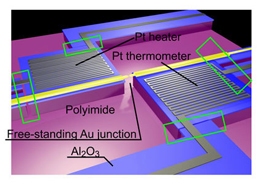Research Abstract
準弾道的な電荷輸送に伴うナノ接合の非対称なホットエレクトロン発熱
Unsymmetrical hot electron heating in quasi-ballistic nanocontacts
2012年1月10日 Scientific Reports 2 : 217 doi: 10.1038/srep00217

2つの電極に接続された単一原子の大きさが非弾性平均自由行程よりはるかに小さいため、電子は単原子接合を散乱されずに通過できる。この準弾道領域では、エネルギー散逸が、通電状態の原子接合系のどこで、どのように起こるかを予測することは難しい。今回我々は、金属ナノ接合における電気的な発熱の直接評価について報告する。我々は、本質的に対称な形状の単原子接合において非対称な電気的な発熱効果を発見した。同時に、非弾性ノイズ分光法により、電圧の極性に依存しない局所加熱の発生を見いだした。その結果、我々は、単原子接合を弾道的に伝導するホットエレクトロンによりかなりの熱が散逸し、電流の下流にホットスポットが生成されることを明らかにした。この手法は、原子/分子系における熱散逸と熱輸送の研究の基盤として用いられる。
- 大阪大学 産業科学研究所
Electrons are allowed to pass through a single atom connected to two electrodes without being scattered as the characteristic size is much smaller than the inelastic mean free path. In this quasi-ballistic regime, it is difficult to predict where and how power dissipation occurs in such current-carrying atomic system. Here, we report direct assessment of electrical heating in a metallic nanocontact. We find asymmetric electrical heating effects in the essentially symmetric single-atom contact. We simultaneously identified the voltage polarity independent onset of the local heating by conducting the inelastic noise spectroscopy. As a result, we revealed significant heat dissipation by hot electrons transmitting ballistically through the junction that creates a hot spot at the current downstream. This technique can be used as a platform for studying heat dissipation and transport in atomic/molecular systems.

